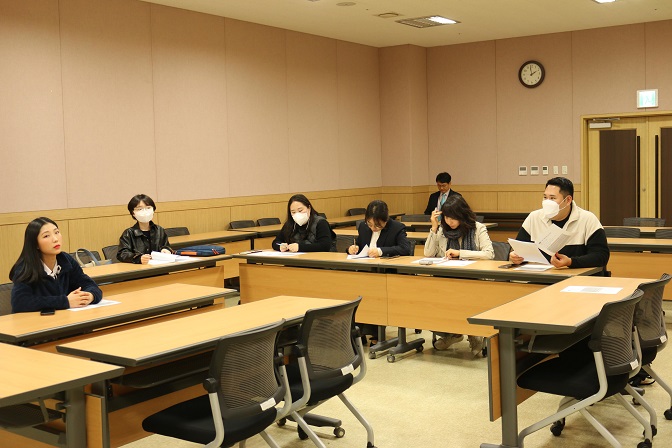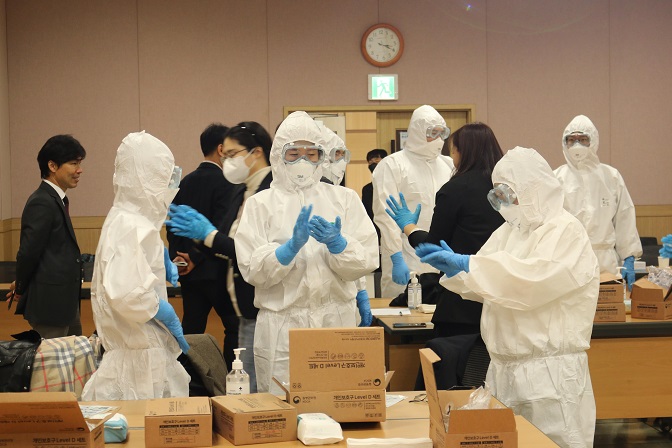
In this photo provided by the Korea Disease Control and Prevention Agency, a mock interview session takes place in Osong, some 108 kilometers south of Seoul, on March 27, 2023.
SEOUL, March 30 (Korea Bizwire) — In March 2027, a new coronavirus infection is reported in South Korea for the first time since the COVID-19 outbreak in 2020.
The world fears the novel coronavirus, named COVID-27 by the World Health Organization, due to a lack of information about the infectious virus.
COVID-27 patients show similar respiratory symptoms to those of COVID-19, but 30 percent of them suffer from vomiting. Patients are strictly quarantined as the disease’s fatality and transmission levels remain uncertain.
This is one of the scenarios for a possible future pandemic that the Korea Disease Control and Prevention Agency (KDCA) presented at a press event in Osong, some 108 kilometers south of Seoul, where the KDCA is headquartered, on Monday.
Under the scenario, two reporters acted as epidemiological investigation officers, or EIOs for short, and had a mock interview with a 25-year old COVID-27 patient, played by a professional actor.
“I don’t want to be questioned. Just let me out!” said Kwon Ye-jin playing the patient, who had been isolated for about a day after she was diagnosed with COVID-27.
“I remember what you did last time. My personal information will be open to the public and all people will blame me.”
The reporters struggled to get necessary information from the patient — her name, age, address, job, symptoms and past contacts — as she remained uncooperative and even got angry during the 15-minute mock interview.
“This is part of our EIO training,” said Ryu Bo-young, a KDCA EIO who led the mock interview session. “We are doing this training always even before the COVID-19 pandemic.”
The epidemic intelligence service was first initiated in the U.S. in 1950s as planning of appropriate defense measures against possible biological warfare during the 1950-53 Korean War.
It is also known as contact tracing, a system implemented to prevent the spread of COVID-19 in the early stage of the pandemic when no vaccine and treatment were available.
South Korea’s 3T strategy — testing, tracing and treatment — was hailed as an effective biosurveillance system to bring the infectious disease under control.

In this photo provided by the Korea Disease Control and Prevention Agency (KDCA), participants put on protective gear during a press event held in Osong, some 108 kilometers south of Seoul, on March 27, 2023.
EIOs, called epidemic intelligence service officers in the United States, played a major role in the pandemic as they investigate, identify the cause, implement control measures and collect evidence to recommend preventive actions.
“They are the first officials who arrive at the site of a disease outbreak,” said Lee Sang-won, director general for public health emergency preparedness at the KDCA.
“They are on the front lines when a disease breaks out or other public health threats emerge.”
South Korea launched the epidemic intelligence service program in 1997 and started a training program with 19 EIOs.
Their roles have stood out in many local public health crises, including the Middle East respiratory syndrome (MERS) epidemic in 2015 and the norovirus outbreak at the 2018 PyeongChang Olympics.
Amid the unprecedented coronavirus pandemic over the recent few years, the number of EIOs in South Korea surged more than sevenfold to 600 in 2023 from 80 in 2019.
The government will maintain the number of EIOs to remain vigilant against the next pandemic.
“There are tens of thousands of viruses around us. As the world is getting closer and closer, there’s a strong possibility that an epidemic can develop into a pandemic,” Lee said.
“Many people think the war is over now and there won’t be another one in the future. But I’m sure that another war will come and we will keep making effort to get ready to fight against it as we always did.”
(Yonhap)






